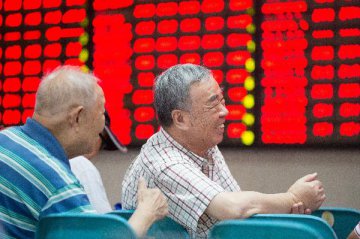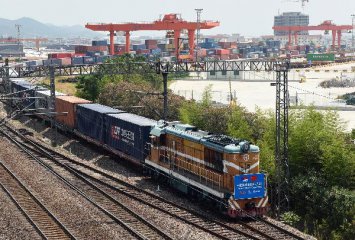A-share market has showed brilliant performance since 2018. Influenced by expectation on economic growth and higher inflation, bond market has been stricken in correction after the New Year.
Institutional analysts think that risk preference of investors is relatively high now, which will facilitate the trend with strong stock and weak bond to continue in the short term. The effect of increasing interest rate is affecting financing cost. The bond market is likely to embrace chance again if risk preference decreases in the future.
Seesaw between stock market and bond market shows up again
The A-share market boomed again yesterday. SSE Composite Index recovered to 3,500 points for the first time since two years ago. It closed at 3,501.36 points and hit 3,503.39 points during trading hours, which was the highest over past two years. The index has risen by over 5.87 percent since 2018.
Price of dominant contract T1803 of 10-year national bond futures totally dropped by 1.78 percent to 91.505 yuan during January 2 and 19. Yield of cash bond at secondary bond market moved up remarkably, and that of bonds issued by China Development Bank (CDB) was adjusted again.
Although national bond underperformed the bonds issued by CDB, 10-year national bond yield was close to 4 percent again. According to ChinaBond government bond yield curve, 10-year national bond yield edged up from 3.88 percent to 3.98 percent from January 2 to 19, and has soared by 10 basis points within this year.
In the opinion of industry insiders, the seesaw effect between stock market and bond market will continue, which meets market expectation. It can be said that no one is bearish about stock market and bullish about bond market.
China International Capital Corporation Limited (CICC) said that based on market investigation, bond investors widely think that the 10-year national bond yield and yield of 10-year bond issued by CDB may surge to 4.2-4.3 percent and 5.3-5.5 percent at most, respectively. This means that investors are bearish about bond market and hold the idea that there’s certain potential for bond yield to rise.
Investors are optimistic about A-share market and expect indexes to hike, according to the latest survey of Fortune Securities. 44.2 percent of investors expect growing trend of SSE Composite Index in next one month, with the proportion up by 8.2 percentage points when compared with last survey.
Risk preference tends to go up
Analysts view that market’s expectation on economy and higher inflation is the fundamental which resulted in strengthening A shares. This is also an important reason factor influencing bond market lately.
CICC said that affected by global investors’ sentiment, China’s stock market overwhelmed the bond market. This implies market’s upbeat expectation on improving economy and increasing inflation and is also a direct response to the hiking risk preference. The weakening US dollar index further enhanced such preference and drove capitals to flow into risky assets and emerging markets. Such optimistic expectation is related with improvement in economic data of some developed countries including European countries, the US and Japan. Economy of emerging markets was also improved and the market widely predicts recovery in global economy.
Guotai Junan Securities said that major reason for the seesaw effect may lie in different expectation on fundamentals. At present, the market is widely upbeat about economic fundamental. Decline in national bond yield is obviously slower since this year. Stock market’s worry about liquidity and interest rate hike which may be resulted from regulation is limited, and investors still focus on the logic about hike in stock price and valuation.
The China Securities Journal reporter learnt that investors’ risk appetite is high at the moment. They are optimistic on the stock market. Some institutions prefer leaning toward the stock market on capital allocation. The recent bustling offerings of equity fund products also reflect the market sentiment to some extent.
According to the latest survey conducted by Haitong Securities, 84 percent of the respondents are bullish on the stock market; the proportion is much higher than those who choose other assets. Came to the second was those who are bullish on commodities, with a proportion of 30 percent, followed by those who are bullish on bond with a proportion of 12 percent.
Still likely to reverse
Analysts said the stock market may perform better than the bond market in the short to medium term. However, as the overall tightening of monetary policy is affecting the global economic recovery, the uptrend of interest rates is transforming to financing costs. If the downward pressure on economic growth appears and t risk appetite decline, the bond market may see opportunity again, and the stock market cannot ignore volatility risk.
Haitong Securities said an increase interest rates will have an impact on corporate bond financing and residential mortgage. Financing contraction will be a certain trend in the future.
Institutional sources believe that bond yields may face upward pressure in the short term, but will return to fundamentals in the medium and long term. There lacks substantial upward momentum. For the stock market, since the beginning of the year, the market has more fully reflected the marginal good news, including easing liquidity and improving risk appetite. Although the stock market is very likely to continue to strengthen, structural differentiation is expected to intensify.
CICC said the current bearish view on the bond market does not mean that there is no opportunity for the bond market this year. Based on the market survey, a relatively high percentage of investors believe that the bond market may see opportunity in the third quarter. On the one hand, it is risk-free when the rate of return rises. On the other hand, the rise of rate of return is also a reflection of the liquidity contraction in the financial system.
Zhongtai Securities proposed that in the long run, the broad liquidity contraction of the bank will surely have an impact on the real economy. When the non-standard restraint effect gradually shows up, the bank’ funds flowing in a more pure way helps to reduce financing costs in the whole society.
From the perspective of dividend-to-yield price ratio, some institutions believe that the timing for a "debt-to-equity seesaw" to reverse may not be far away.
TF Securities pointed out that historical data shows that there is a relatively obvious price relationship between the interest rate level and the dividend yield. Currently, the difference between the SSE 50 dividend yield and the 10-year CDB interest rate once again returns to a high level. In the second half of 2017, the bank dividend yield, as represented by the traditional high dividend, fell below the CDB interest rate and declined at a faster pace since the beginning of the year. The divergence between dividend rates and interest rates is close to a time of reversal.
(By Coral & Vanessa)
Institutional analysts think that risk preference of investors is relatively high now, which will facilitate the trend with strong stock and weak bond to continue in the short term. The effect of increasing interest rate is affecting financing cost. The bond market is likely to embrace chance again if risk preference decreases in the future.
Seesaw between stock market and bond market shows up again
The A-share market boomed again yesterday. SSE Composite Index recovered to 3,500 points for the first time since two years ago. It closed at 3,501.36 points and hit 3,503.39 points during trading hours, which was the highest over past two years. The index has risen by over 5.87 percent since 2018.
Price of dominant contract T1803 of 10-year national bond futures totally dropped by 1.78 percent to 91.505 yuan during January 2 and 19. Yield of cash bond at secondary bond market moved up remarkably, and that of bonds issued by China Development Bank (CDB) was adjusted again.
Although national bond underperformed the bonds issued by CDB, 10-year national bond yield was close to 4 percent again. According to ChinaBond government bond yield curve, 10-year national bond yield edged up from 3.88 percent to 3.98 percent from January 2 to 19, and has soared by 10 basis points within this year.
In the opinion of industry insiders, the seesaw effect between stock market and bond market will continue, which meets market expectation. It can be said that no one is bearish about stock market and bullish about bond market.
China International Capital Corporation Limited (CICC) said that based on market investigation, bond investors widely think that the 10-year national bond yield and yield of 10-year bond issued by CDB may surge to 4.2-4.3 percent and 5.3-5.5 percent at most, respectively. This means that investors are bearish about bond market and hold the idea that there’s certain potential for bond yield to rise.
Investors are optimistic about A-share market and expect indexes to hike, according to the latest survey of Fortune Securities. 44.2 percent of investors expect growing trend of SSE Composite Index in next one month, with the proportion up by 8.2 percentage points when compared with last survey.
Risk preference tends to go up
Analysts view that market’s expectation on economy and higher inflation is the fundamental which resulted in strengthening A shares. This is also an important reason factor influencing bond market lately.
CICC said that affected by global investors’ sentiment, China’s stock market overwhelmed the bond market. This implies market’s upbeat expectation on improving economy and increasing inflation and is also a direct response to the hiking risk preference. The weakening US dollar index further enhanced such preference and drove capitals to flow into risky assets and emerging markets. Such optimistic expectation is related with improvement in economic data of some developed countries including European countries, the US and Japan. Economy of emerging markets was also improved and the market widely predicts recovery in global economy.
Guotai Junan Securities said that major reason for the seesaw effect may lie in different expectation on fundamentals. At present, the market is widely upbeat about economic fundamental. Decline in national bond yield is obviously slower since this year. Stock market’s worry about liquidity and interest rate hike which may be resulted from regulation is limited, and investors still focus on the logic about hike in stock price and valuation.
The China Securities Journal reporter learnt that investors’ risk appetite is high at the moment. They are optimistic on the stock market. Some institutions prefer leaning toward the stock market on capital allocation. The recent bustling offerings of equity fund products also reflect the market sentiment to some extent.
According to the latest survey conducted by Haitong Securities, 84 percent of the respondents are bullish on the stock market; the proportion is much higher than those who choose other assets. Came to the second was those who are bullish on commodities, with a proportion of 30 percent, followed by those who are bullish on bond with a proportion of 12 percent.
Still likely to reverse
Analysts said the stock market may perform better than the bond market in the short to medium term. However, as the overall tightening of monetary policy is affecting the global economic recovery, the uptrend of interest rates is transforming to financing costs. If the downward pressure on economic growth appears and t risk appetite decline, the bond market may see opportunity again, and the stock market cannot ignore volatility risk.
Haitong Securities said an increase interest rates will have an impact on corporate bond financing and residential mortgage. Financing contraction will be a certain trend in the future.
Institutional sources believe that bond yields may face upward pressure in the short term, but will return to fundamentals in the medium and long term. There lacks substantial upward momentum. For the stock market, since the beginning of the year, the market has more fully reflected the marginal good news, including easing liquidity and improving risk appetite. Although the stock market is very likely to continue to strengthen, structural differentiation is expected to intensify.
CICC said the current bearish view on the bond market does not mean that there is no opportunity for the bond market this year. Based on the market survey, a relatively high percentage of investors believe that the bond market may see opportunity in the third quarter. On the one hand, it is risk-free when the rate of return rises. On the other hand, the rise of rate of return is also a reflection of the liquidity contraction in the financial system.
Zhongtai Securities proposed that in the long run, the broad liquidity contraction of the bank will surely have an impact on the real economy. When the non-standard restraint effect gradually shows up, the bank’ funds flowing in a more pure way helps to reduce financing costs in the whole society.
From the perspective of dividend-to-yield price ratio, some institutions believe that the timing for a "debt-to-equity seesaw" to reverse may not be far away.
TF Securities pointed out that historical data shows that there is a relatively obvious price relationship between the interest rate level and the dividend yield. Currently, the difference between the SSE 50 dividend yield and the 10-year CDB interest rate once again returns to a high level. In the second half of 2017, the bank dividend yield, as represented by the traditional high dividend, fell below the CDB interest rate and declined at a faster pace since the beginning of the year. The divergence between dividend rates and interest rates is close to a time of reversal.
(By Coral & Vanessa)






















Latest comments